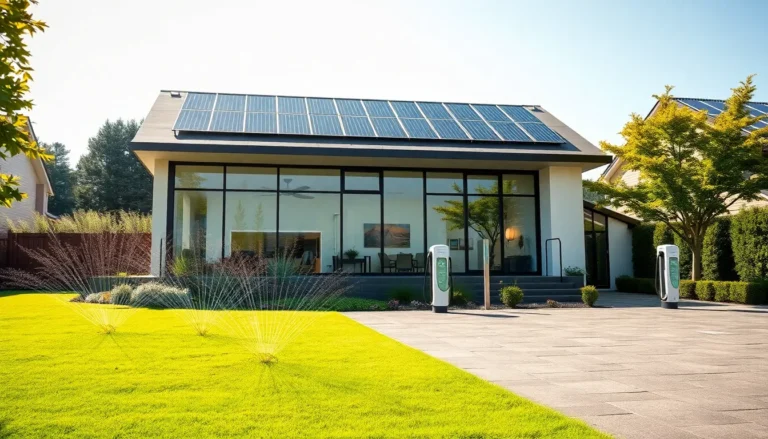In the land of sunshine and innovation, California is taking smart living to new heights. Imagine coming home to a house that knows your energy preferences better than you do, all while saving you bucks on your utility bills. That’s right: California energy smart homes are not just a trend: they are the wave of the future. With smart technologies rising like a perfectly baked sourdough loaf, it’s time to jump into how these homes are redefining energy efficiency with a sprinkle of innovation and a dash of sustainability.
Table of Contents
ToggleOverview of Smart Home Technology

Smart home technology transforms everyday living, making homes more responsive and efficient. By incorporating devices connected to the Internet of Things (IoT), homeowners can streamline everything from lighting and heating to security. These devices communicate with each other, creating an ecosystem that enhances convenience and optimizes energy usage. For instance, smart thermostats learn your preferences and adjust temperatures accordingly, ensuring comfort while minimizing energy waste. As sensor technology becomes pervasive, smart homes continue to evolve, offering features like remote monitoring and automated alerts to enhance user experiences.
Benefits of Energy Efficiency in Smart Homes
Energy efficiency is more than a buzzword: it’s the backbone of sustainable living in California. Not only do smart homes reduce energy consumption, but they also help save substantial money on utility bills. Homeowners often report up to 30% reductions in energy costs after integrating smart technologies. Also, energy-efficient homes contribute to a lower carbon footprint, making them an eco-friendly option for-conscious consumers. The ability to monitor energy usage in real-time encourages responsible habits and empowers individuals to make informed decisions about their energy consumption.
Key Features of California Energy Smart Homes
California energy smart homes come packed with innovative features that set them apart. Here are the main aspects:
Renewable Energy Integration
Imagine harnessing the sun to power your living room lights. Many California homes now incorporate rooftop solar panels, allowing residents to generate their own electricity. This not only lowers energy costs but also enables homeowners to sell excess energy back to the grid, creating a win-win situation.
Smart Appliances and Devices
From fridges that remind you when to restock to washing machines that optimize water usage, smart appliances are changing household management. These devices use sensors and connectivity to adjust performance based on your behavior, maximizing efficiency while minimizing environmental impact.
Home Automation Systems
Home automation systems serve as the central nervous system of smart homes. They enable homeowners to control lighting, heating, and even security systems from a single hub. This interconnectedness enhances convenience while optimizing energy use through programmable schedules and remote access.
Regulatory Framework and Incentives
Navigating the complexities of energy regulations can be challenging. Fortunately, California offers a robust framework to support energy efficiency initiatives.
State Initiatives for Energy Efficiency
California has ambitious goals to achieve significant energy reductions by 2030. Programs like the California Energy Star program push for energy-efficient home designs and renovations, encouraging builders and homeowners to adopt smarter practices.
Incentives for Homeowners
The state also provides several financial incentives, including rebates, tax credits, and low-interest loans, to encourage homeowners to upgrade to smart technologies. These financial advantages make the prospect of energy-efficient homes more accessible to a broader audience.
Impact on Energy Consumption and Cost Savings
The impact of adopting smart home technologies is significant. With enhanced energy efficiency, California homeowners can see substantial reductions in consumption. Studies show that homes equipped with smart technology can reduce monthly energy expenditures by up to 50%. Also, this leads to a collective decrease in energy demand on the grid, enabling better energy distribution and lower rates for all consumers. As more households make the shift, the benefits permeate throughout communities, promoting a culture of efficiency and sustainability.
Case Studies of Successful Energy Smart Homes
Several California homes showcase the successful integration of smart technology:
- The Green House Project in San Francisco features solar panels and smart systems that manage energy consumption seamlessly. Homeowners reported saving upwards of $1200 annually in energy costs.
- The Eco Villa in Los Angeles utilizes an advanced home automation system that controls everything from lighting to temperature with precision. Initial studies showed a 35% decrease in energy bills.
- The Smart Haven, a development in Oakland, integrates community solar systems, allowing homeowners to share energy, leading to lower costs and improved sustainability markers across the neighborhood.
Future Trends in Smart Home Energy Management
Looking ahead, several trends will shape the future of smart home energy management. Increased reliance on artificial intelligence will enable smarter devices that anticipate needs and optimize efficiency without user intervention. Also, advancements in battery storage technology will allow homes to store excess energy for later use, reducing reliance on the grid during peak hours. With smart technology becoming more affordable, the market will likely see a surge in retrofitting older homes with energy-efficient systems, widening the reach of smart home benefits.


